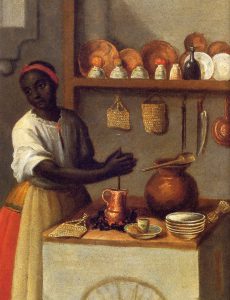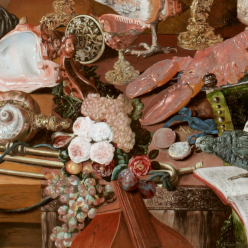
De español y negra, mulato, 6. (detail)
José de Páez, Mexico, ca. 1770-1780
Oil on canvas
Private collection
de Páez, José. No. 4. De español y negra, nace mulata (From Spaniard and Black, a Mulata is Born). 1774. Oil on canvas. Museo de América, Madrid. In Casta Painting: Images of Race in Eighteenth-Century Mexico. New Haven: Yale University Press, 2004, 24.
This detail is a part of a casta painting produced by José de Páez in Mexico. In the painting, a woman of African descent is being depicted as a preparer of hot chocolate for her Spanish husband. This hot chocolate would be served in a jicara or chocolate cup that was used specifically for drinking hot chocolate. This detail is an example of how chocolate and the chocolate cup would become associated with women who were the common preparers of the beverage.
Hot chocolate was a beverage that was the most universally embraced by European settlers of the New World. Colonial writers almost unanimously praised the beverage and declared that it was “the healthiest and most sustaining food in the world”.[1] Since the consumption of chocolate constituted European’s first exposure to the caffeine, it is likely that Europeans thought chocolate was stimulating and beneficial to one’s health. Hot chocolate, in fact, became immensely popular to the point that it was considered a geographically appropriate substitute for wine.
In the mid-sixteenth century, chocolate consumption was widespread because there was a shortage of Spanish women in the New World. This shortage motivated settlers to depend on indigenous women for meal preparation. However, when colonial settlement was established for a few decades, chocolate was seen as a drink that was favored by women in particular. With this association, Europeans’ attitudes towards indigenous women as welcomed preparers of chocolate transformed into a fear of the power they could exert with the product.
For Europeans, their reliance on indigenous women to prepare, serve, and drink chocolate transforms into a fear of their spirituality. Chocolate became associated with sexual witchcraft and had aphrodisiac qualities that women took advantage of to exert power over the men in their lives. Women were therefore placed on Inquisition trials by the Church for preparing and using of chocolate as a mechanism for controlling men’s sexuality. While clergy members like the English priest Thomas Gage privately prepared and consumed chocolate for themselves, the Church fearfully condemned women’s use of chocolate in a contradictory manner.
[1] Rebecca Earle, The Body of the Conquistador: Food, Race and the Colonial Experience in Spanish America, 1492-1700 (New York: Cambridge University Press, 2012), 131.
Sources:
Earle, Rebecca. The Body of the Conquistador: Food, Race and the Colonial Experience in Spanish America, 1492-1700. New York, NY: Cambridge University Press, 2012.
Few, Martha. “Chocolate, Sex, and Disorderly Women in Late-Seventeenth- and Early-Eighteenth-Century Guatemala.” Ethnohistory, vol. 52, no. 4, Fall 2005.
Gage, Thomas. The English American: A New Survey of the West Indies, 1648. New York: Routledge, 1928. Accessed October 8, 2018. https://books.google.com/books?isbn=0429868251.
Norton, Marcy. Sacred Gifts, Profane Pleasures: A History of Tobacco and Chocolate in the Atlantic World. Ithaca, NY: Cornell University Press, 2010.
